|
Comets
|
|
| SpaceEngineer | Date: Thursday, 25.10.2012, 22:00 | Message # 1 |
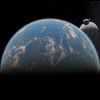 Author of Space Engine
Group: Administrators
 Russian Federation
Russian Federation
Messages: 4800
Status: Offline
| I've been working a few weeks on implementing comet tails. They are based on axis-aligned sprites, animated in the vertex shader. This mean that the sprite is rendered as a long oval, while viewing it from the side, and is round while viewing from the top (the same principle is used for the stars motion blur). In SE I can't use an iterative simulation for moving particles, so particles in the comet tails are moved using formulas, that allows computing the position of the particle at any moment in time. Rendering of thousands of transparent sprites is an extremely big load for the graphics card, so to increase performance, comets are rendered to impostors or a low-res framebuffer - the same system is used for galaxies and nebulae.
Here's a bunch of screenshots. I'll upload a short video showing an animation of the particles later.
View on comet Halley from Earth at dawn:
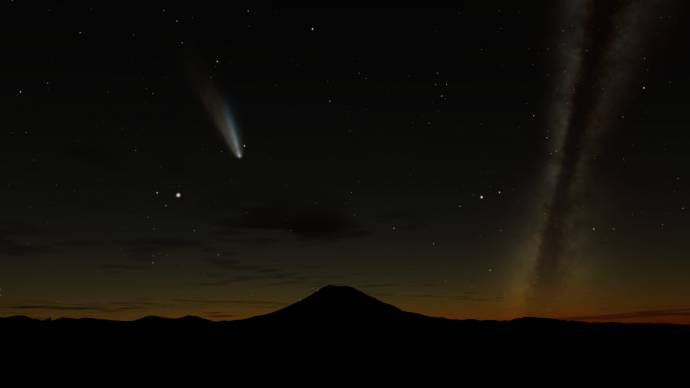
View from space.
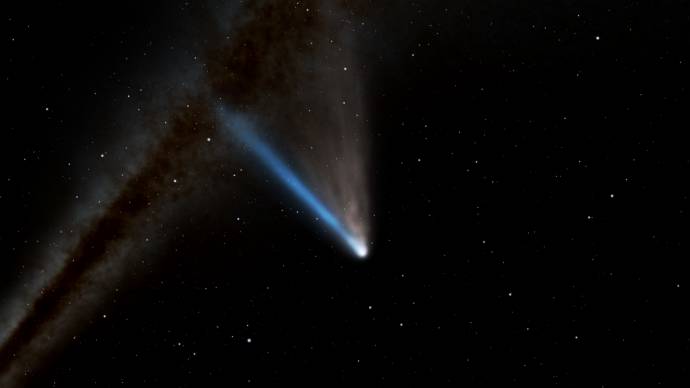
View of the comet's core. When I implement volcanos (the particle system needed for the planetary surface), I'll add a few geysers to the comet's core.

A set of images showing a change in the comet's shape during its orbital motion. Note the blue ion tail and a few grey dust tails. Ions in the ion tail interact with the solar wind - it blows them away, so the tail is always directed away from the sun. Blue color is due to luminescence. Dust tail particles are accelerated by solar light pressure and Poynting–Robertson effect. Both forces make them lag behind the comet's core, so they tend to follow the comet's orbit. The dust tail color is a sun color, scattered on the dust particles.
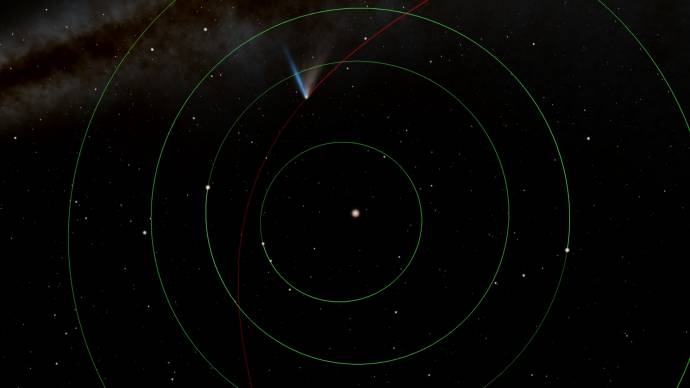
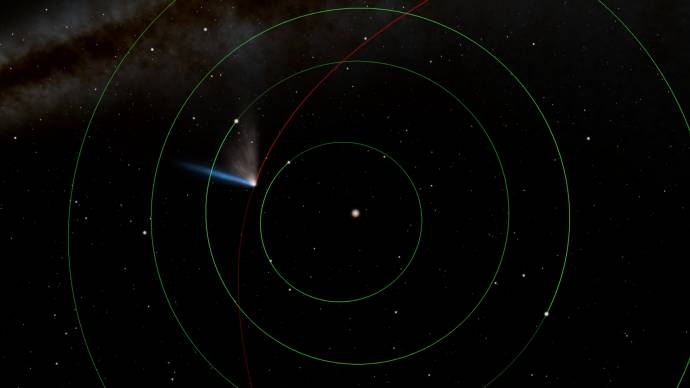
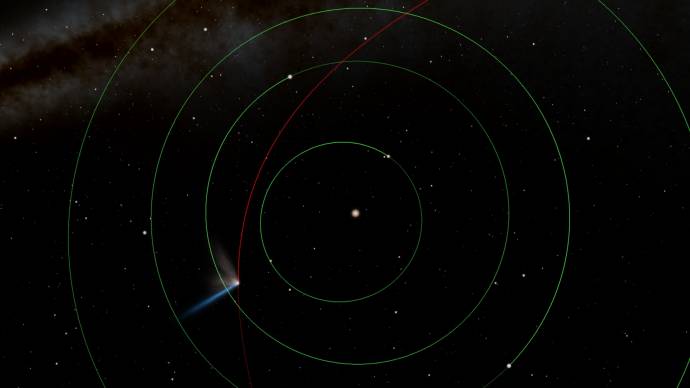
A comet-rich procedural system. Note comet tails are always directed outwards from sun.
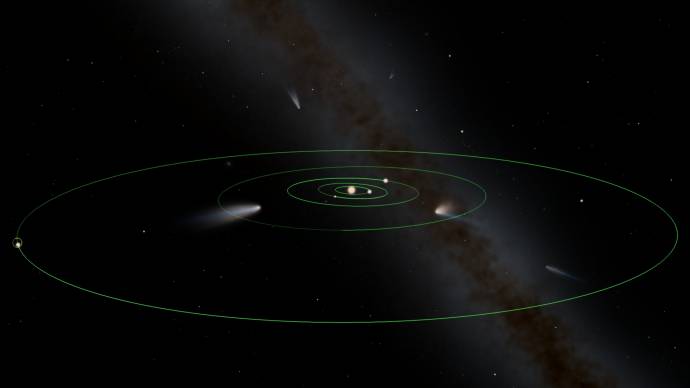
Orbits of the comets in the same system. SE can't handle too many bodies for now, so I've limited the number of comets to a few hundred (the number of asteroids is limited too).
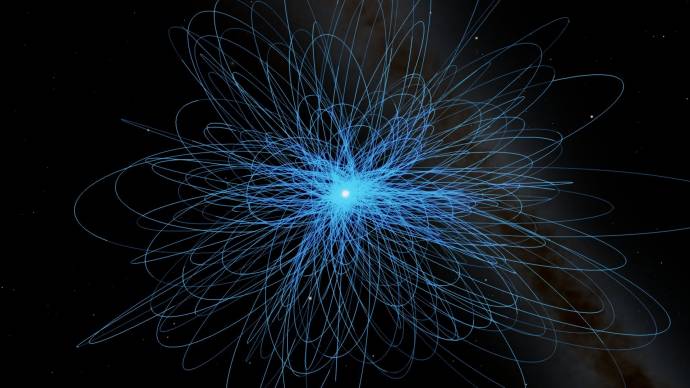
View from the surface of some procedural planet with a thin Mars-like atmosphere. On planets with thick atmospheres, comets are invisible at daytime, just like the stars and Milky Way are.
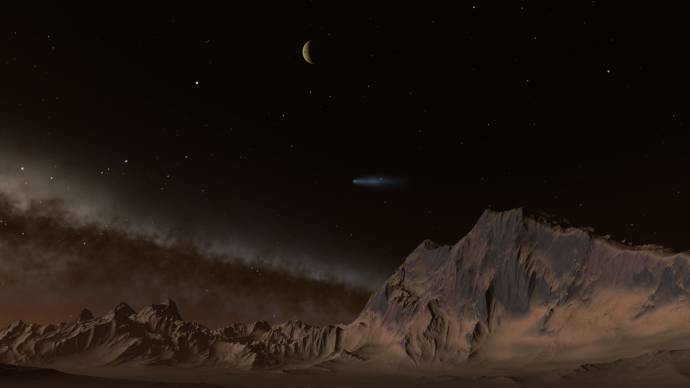
*
|
| |
| |
| SpaceEngineer | Date: Thursday, 25.10.2012, 22:25 | Message # 2 |
 Author of Space Engine
Group: Administrators
 Russian Federation
Russian Federation
Messages: 4800
Status: Offline
| The comet tail system can be used to simulate evaporating planets. Here is a procedural system with two very hot desert planets (with average temperatures of 2000K and 1500K). With this temperature they should lose their atmospheres, making a giant comet-like tail. Note the powerful dust tails. Hot desert planets have a melted surface, and their atmospheres are saturated with silicate vapor that may condensate into a thin dust in space. Also, a powerful wind should blow dust from the surface high into the atmosphere, where it may be blown-out with an escaping gas flow. The first planet of this system is a scorched selena that has already lost its atmosphere (however, at 2000K its surface should melt, and form a silicate vapor atmosphere, that will run out into space again).
Lens flares and Real planet brightness are disabled on these images.
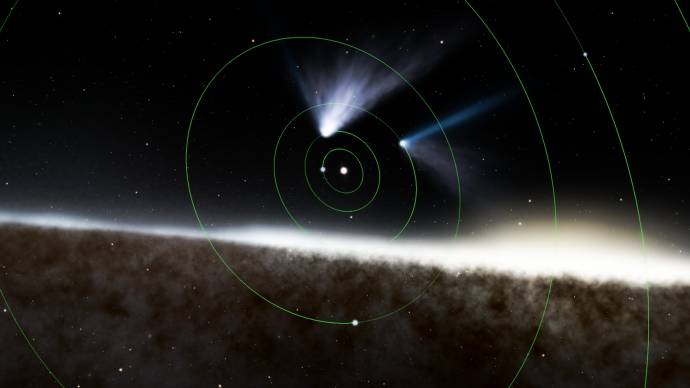
Views from one evaporating planet to another (on the second screenshot, the sun is lurking behind the disk of the planet). There is some trouble with the comet tails for now - they are rendered in the background, so you can't see a haze effect around a planet. More work on the planetary rendering system and overall engine should be done to achieve the correct hazing effect.
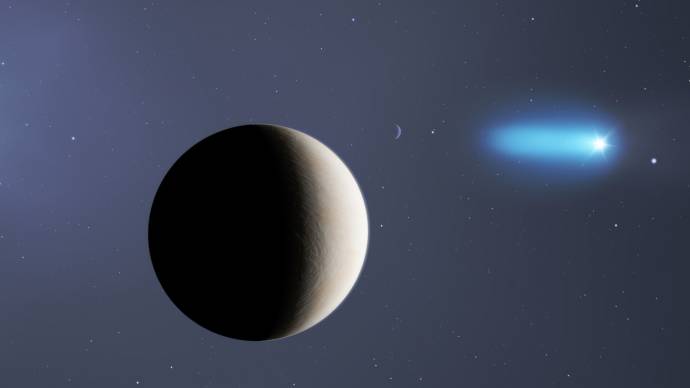
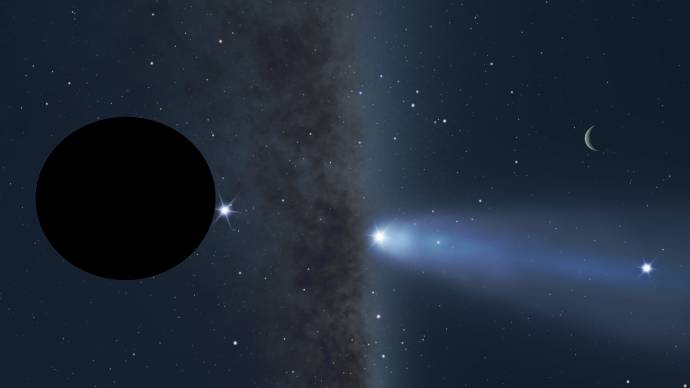
And this is the famous HD 209458 b, an evaporating hot gas giant, also knows as Osiris. Note there almost no dust tail is visible, because it is a gas giant, and its atmosphere is made of hydrogen and helium. The color of the ion tail should be adjusted to simulate the actual gas luminescence spectrum.
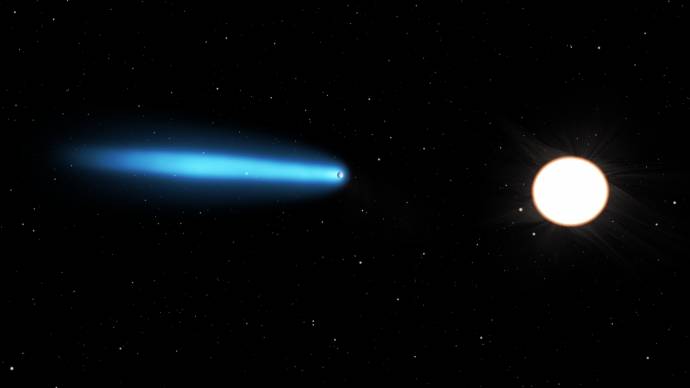
*
|
| |
| |
| anonymousgamer | Date: Thursday, 25.10.2012, 22:30 | Message # 3 |
 World Builder
Group: Global Moderators
 United States
United States
Messages: 1011
Status: Offline
| This looks amazingly beautiful, a lot better looking than I thought it was going to look. And I did not expect the evaporating planets. I wonder what the performance impact will be.
I can't wait. It feels like I'm waiting for a new Minecraft updated, except... better.
Desktop: FX-8350 4.0 GHz, 8 GB DDR3 RAM, EVGA GeForce GTX 1080 FTW 8 GB, 2 TB HDD, 24 inch 1920x1080 screen
Laptop: Core i5 480M 2.66 GHz (turbo 2.93), 8 GB DDR3 RAM, AMD Radeon HD 6550m 1 GB, 640 GB HDD, 17.3 inch 1600x900 screen
|
| |
| |
| HarbingerDawn | Date: Thursday, 25.10.2012, 22:40 | Message # 4 |
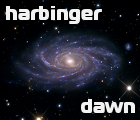 Cosmic Curator
Group: Administrators
 United States
United States
Messages: 8717
Status: Offline
| Wow, those look AMAZING! I never dreamed they would look that nice! Why didn't you post this in the work progress thread though? Just curious.
On an unrelated note, have you given any thought to implementing user-specified procedural asteroid belt generation yet? It would really allow for richer custom systems, and could also add well to the exoplanets catalog for systems like EPS Eri, which is known to have two asteroid belts and one Kuiper belt-like comet belt.
Anyway, I hope this next release sees light relatively soon. Would make a fantastic Christmas/New Year's present!
All forum users, please read this!
My SE mods and addons
Phenom II X6 1090T 3.2 GHz, 16 GB DDR3 RAM, GTX 970 3584 MB VRAM
|
| |
| |
| smjjames | Date: Thursday, 25.10.2012, 22:40 | Message # 5 |
|
World Builder
Group: Users
 United States
United States
Messages: 913
Status: Offline
| Looks awesome man, can't wait for those comets. 
One of the first things I did when getting SE (or one of the early things I tried to do) was to look for Halley's comet.
Will you be including the short period comets as well as the long period ones? I think my question got answered with the image up there.
Edit: I guess you will be adding those tails to other catalog and procedural hot jupiters?
Also, $image8$ on the first post is missing the uploaded image.

Edited by smjjames - Thursday, 25.10.2012, 23:39 |
| |
| |
| curiousepic | Date: Thursday, 25.10.2012, 22:55 | Message # 6 |
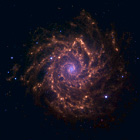 Space Pilot
Group: SE team
 United States
United States
Messages: 141
Status: Offline
| Sorry I've been absent for a while - just wanted to stop by and say these look incredible!
How common would actively evaporating planets be, realistically?
Can planets with highly elliptical orbits dynamically be evaporating or not, depending on distance?
My ideal preferences for visual design of the mothership and technology in SE
Harry Potter and the Methods of Rationality
|
| |
| |
| smjjames | Date: Thursday, 25.10.2012, 23:45 | Message # 7 |
|
World Builder
Group: Users
 United States
United States
Messages: 913
Status: Offline
| Oh yeah, will the tail of both the comets and evaporating planetary atmospheres change length with distance from it's star? I'm just wondering if that part is implemented yet.

|
| |
| |
| SpaceEngineer | Date: Friday, 26.10.2012, 00:22 | Message # 8 |
 Author of Space Engine
Group: Administrators
 Russian Federation
Russian Federation
Messages: 4800
Status: Offline
| Quote (HarbingerDawn) On an unrelated note, have you given any thought to implementing user-specified procedural asteroid belt generation yet?
Yes, if I make a new planetary system generation code. With the current code it is very difficult to implement.
Quote (smjjames) Oh yeah, will the tail of both the comets and evaporating planetary atmospheres change length with distance from it's star?
Of course.

|
| |
| |
| Freak2121 | Date: Friday, 26.10.2012, 00:50 | Message # 9 |
 Space Pilot
Group: Users
 Canada
Canada
Messages: 89
Status: Offline
| Wow. That's just beautiful.
Intel Core i5 @ 4.534GHz
8GBs of DDR3 RAM @ 1600mhz
EVGA GTX970 SSC
Windows 7 64-bit
|
| |
| |
| dave | Date: Friday, 26.10.2012, 01:16 | Message # 10 |
|
Space Tourist
Group: Users
 United States
United States
Messages: 35
Status: Offline
| Oh lord space engineer you are a genius. It's safe to say this will be .97
|
| |
| |
| Glorymajor | Date: Friday, 26.10.2012, 02:37 | Message # 11 |
 Space Tourist
Group: Users
 Brazil
Brazil
Messages: 30
Status: Offline
| Niceeeeeeeeeee!!!!! O.O
PC: Intel i7 3.2 GHz, 8 Gb RAM, GeForce GTX 680 with 2048 Mb VRAM
Laptop: Intel i7 2.3 GHz, 8 Gb RAM, GeForce GTX 675M with 2048 Mb VRAM
|
| |
| |
| Toty | Date: Friday, 26.10.2012, 08:29 | Message # 12 |
 Explorer
Group: SE team
 Spain
Spain
Messages: 158
Status: Offline
| Amazing work SpaceEngineer! I can't wait to try it. 
|
| |
| |
| apenpaap | Date: Friday, 26.10.2012, 12:31 | Message # 13 |
 World Builder
Group: Users
 Antarctica
Antarctica
Messages: 1063
Status: Offline
| That's really cool, I never expected it to be this awesome. I really like the evaporating planets too.
I occasionally stream at http://www.twitch.tv/magistermystax. Sometimes SE, sometimes other games.
|
| |
| |
| n3xt | Date: Friday, 26.10.2012, 13:42 | Message # 14 |
 Explorer
Group: Users
 Netherlands
Netherlands
Messages: 184
Status: Offline
| Absolutely speechless... 
First of all I was totally excited about the coming ''Desaturation of the faint stars'' thing...
Then the awesome galaxy improvement...
And now this???
WOOOOOOOOOOOOOOOOW 
Splendid job ''Vladimir'' 
...
Edited by n3xt - Friday, 26.10.2012, 16:29 |
| |
| |
| HarbingerDawn | Date: Friday, 26.10.2012, 15:03 | Message # 15 |
 Cosmic Curator
Group: Administrators
 United States
United States
Messages: 8717
Status: Offline
|
All forum users, please read this!
My SE mods and addons
Phenom II X6 1090T 3.2 GHz, 16 GB DDR3 RAM, GTX 970 3584 MB VRAM
|
| |
| |